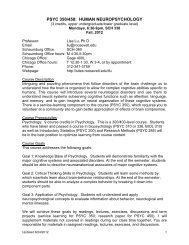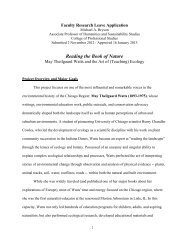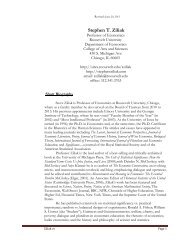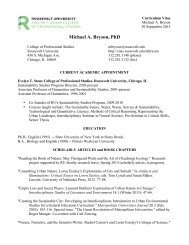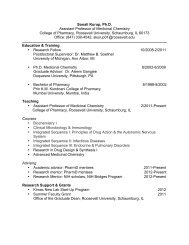Social Insurance and Public Assistance
public-assistance-welfare-reform-colonial-times-to-the-present-ziliak ...
public-assistance-welfare-reform-colonial-times-to-the-present-ziliak ...
You also want an ePaper? Increase the reach of your titles
YUMPU automatically turns print PDFs into web optimized ePapers that Google loves.
SOCIAL WELFARE PROGRAMS Series Bf621–633 799<br />
TABLE Bf621–633 <strong>Public</strong> assistance – recipients <strong>and</strong> annual payments, by program: 1933–1975<br />
[Earlier estimates] Continued<br />
Annual payments<br />
Recipients<br />
Aid to the Aid to the Aid to the Institutional<br />
Aid to Families with<br />
Permanently Families with Permanently services in<br />
Dependent Children<br />
Old-Age Aid to <strong>and</strong> Totally Dependent General Old-Age Aid to <strong>and</strong> Totally General intermediate-<br />
<strong>Assistance</strong> the Blind Disabled Children assistance <strong>Assistance</strong> the Blind Disabled Families All persons Children assistance care facilities<br />
Bf621 1 Bf622 1 Bf623 1 Bf624 Bf625 Bf626 1 Bf627 1 Bf628 1 Bf629 Bf630 Bf631 Bf632 Bf633<br />
Thous<strong>and</strong> Thous<strong>and</strong> Thous<strong>and</strong> Thous<strong>and</strong> Thous<strong>and</strong><br />
Year dollars dollars dollars dollars dollars Thous<strong>and</strong> Thous<strong>and</strong> Thous<strong>and</strong> Thous<strong>and</strong> Thous<strong>and</strong> Thous<strong>and</strong> Thous<strong>and</strong> Thous<strong>and</strong><br />
1950 1,453,900 52,600 8,000 547,200 292,800 2,786 97 69 651 2,233 1,661 866 —<br />
1951 1,427,600 54,500 54,300 548,800 194,500 2,701 97 124 592 2,041 1,523 664 —<br />
1952 1,462,900 59,600 81,500 538,000 169,500 2,635 98 161 596 1,991 1,495 587 —<br />
1953 1,513,300 63,600 102,000 544,000 151,300 2,582 100 192 547 1,941 1,464 618 —<br />
1954 1,497,600 65,200 119,800 573,100 196,000 2,553 102 222 604 2,173 1,639 880 —<br />
1955 1,488,000 67,800 134,600 612,200 214,000 2,538 104 241 602 2,192 1,661 743 —<br />
1956 1,529,000 72,900 150,100 634,900 197,200 2,499 107 266 615 2,270 1,731 731 —<br />
1957 1,609,400 78,700 172,200 716,800 211,100 2,480 108 290 667 2,497 1,912 907 —<br />
1958 1,647,400 81,500 196,600 839,900 303,300 2,438 110 325 755 2,486 2,181 1,246 —<br />
1959 1,620,700 83,600 217,300 937,200 342,000 2,370 108 346 776 2,946 2,265 1,107 —<br />
1960 1,626,000 86,100 236,400 994,400 319,500 2,305 107 369 803 3,073 2,370 1,244 —<br />
1961 1,569,000 84,500 255,600 1,148,800 351,400 2,229 103 389 916 3,566 2,753 1,069 —<br />
1962 1,566,100 83,900 281,100 1,289,800 289,500 2,183 99 428 932 3,789 2,844 900 —<br />
1963 1,610,300 85,100 317,700 1,355,500 277,400 2,152 97 464 954 3,930 2,951 872 —<br />
1964 1,606,600 86,200 355,600 1,496,500 270,300 2,120 95 509 1,012 4,219 3,170 779 —<br />
1965 1,594,200 77,300 416,800 1,644,100 260,600 2,087 85 557 1,054 4,396 3,316 677 —<br />
1966 1,630,100 84,700 487,200 1,849,900 251,900 2,073 84 588 1,127 4,666 3,526 663 —<br />
1967 1,698,100 87,000 573,600 2,249,700 323,100 2,073 83 646 1,297 5,309 3,986 782 —<br />
1968 1,673,200 87,800 655,800 2,823,800 419,500 2,027 81 702 1,522 6,086 4,555 826 14<br />
1969 1,746,700 91,400 786,800 3,533,300 474,500 2,074 81 803 1,875 7,313 5,413 860 92<br />
1970 1,866,100 97,500 975,500 4,857,200 632,400 2,082 81 935 2,552 9,659 7,033 1,056 163<br />
1971 1,919,700 100,700 1,185,300 6,230,400 760,600 2,024 80 1,068 2,918 10,653 7,707 982 196<br />
1972 1,894,000 104,700 1,392,900 7,019,600 741,000 1,933 80 1,169 3,123 11,069 7,986 865 —<br />
1973 1,749,300 103,000 1,566,100 7,291,900 688,100 1,820 78 1,275 3,156 10,815 7,813 700 —<br />
1974 4,800 100 3,000 7,990,800 825,400 19 (Z) 17 3,312 11,006 7,885 851 —<br />
1975 4,600 100 2,900 9,348,900 1,138,000 19 (Z) 17 3,555 11,389 8,090 977 —<br />
(Z) Fewer than 500 recipients.<br />
1 Beginning in 1974, includes only Puerto Rico, Guam, <strong>and</strong> the Virgin Isl<strong>and</strong>s. See text.<br />
Sources<br />
U.S. <strong>Social</strong> Security Administration, <strong>Social</strong> Security Bulletin, Annual Statistical<br />
Supplement (1975), Table 175, <strong>and</strong> <strong>Social</strong> Security Bulletin, Annual Statistical Supplement<br />
(1966), Table 113. For years 1933–1935: <strong>Social</strong> Security Bulletin 14 (9)<br />
(1951): 43.<br />
Documentation<br />
Prior to 1935 public assistance was a state <strong>and</strong> local responsibility. After the<br />
<strong>Social</strong> Security Administration Act of 1935, assistance programs financed in<br />
part by federal grants-in-aid were in effect on a statewide basis in 1936 in<br />
forty-two states for Old-Age <strong>Assistance</strong>, twenty-seven states for Aid to Dependent<br />
Children, <strong>and</strong> twenty-five states for Aid to the Blind. Programs have<br />
been in effect in the forty-eight contiguous states <strong>and</strong> the District of Columbia<br />
beginning 1938 for Old-Age <strong>Assistance</strong>, 1955 for Aid to Dependent Children,<br />
<strong>and</strong> 1953 for Aid to the Blind. Approval of the first plans for Aid to the Permanently<br />
<strong>and</strong> Totally Disabled was effective October 1950 <strong>and</strong>, in 1957,<br />
forty-four states <strong>and</strong> the District of Columbia were participating. <strong>Assistance</strong><br />
payments for all the previously mentioned programs were still financed in<br />
part from federal funds <strong>and</strong>, with the exception of Nevada (Aid to the Permanently<br />
<strong>and</strong> Totally Disabled), these programs were in effect in all fifty<br />
states, the District of Columbia, Guam, Puerto Rico, <strong>and</strong> Virgin Isl<strong>and</strong>s until<br />
1974. General assistance, provided from state or local funds or both, is available<br />
to certain other categories of needy persons in all fifty-four jurisdictions.<br />
Beginning in the <strong>Social</strong> Security Bulletin, Annual Statistical Supplement (1976),<br />
p. 200, data on the <strong>Public</strong> <strong>Assistance</strong> programs were reported from a different<br />
source, <strong>and</strong> the new series reported were considered not comparable with<br />
the previously listed series. See Table Bf634–648 for modern information on<br />
these programs back to 1960 <strong>and</strong> for 1955, 1950, 1945, 1940, <strong>and</strong> 1936.<br />
Series Bf630. Aid to Families with Dependent Children (AFDC) recipients<br />
include children <strong>and</strong> one or both parents, or one caretaker relative other<br />
than a parent, in families in which the requirements of such adults were<br />
considered in determining the amount of assistance. The figure is partially<br />
estimated before 1950. The program for Aid to Dependent Children began<br />
paying benefits to support payments for a mother or other relative caring<br />
for the child in 1950. Under the <strong>Public</strong> Welfare Amendments of 1962, the<br />
program was renamed Aid to Families with Dependent Children to reflect exp<strong>and</strong>ed<br />
coverage of the adults caring for the dependent children. The AFDC<br />
<strong>and</strong> the Emergency <strong>Assistance</strong> programs have been replaced by the Temporary<br />
<strong>Assistance</strong> for Needy Families program under the Personal Responsibility<br />
<strong>and</strong> Work Opportunity Reconciliation Act of 1996. The Act was designed to<br />
limit the length of time that families could receive assistance <strong>and</strong> promote a<br />
return to the work force by those who are able.<br />
Series Bf632. Partly estimated. For certain periods, the series excludes data<br />
for Florida, Idaho, Indiana, Kentucky, Nebraska, Nevada, New Mexico,<br />
Tennessee, Texas, <strong>and</strong> Vermont. The number of recipients in 1933–1935<br />
was not reported, but the number of cases was 3.246 million in 1933, 5.368<br />
million in 1934, 2.89 million in 1935, <strong>and</strong> 1.51 million in 1936.<br />
Series Bf621–623 <strong>and</strong> Bf626–628. Beginning in 1974, includes only Puerto<br />
Rico, Guam, <strong>and</strong> the Virgin Isl<strong>and</strong>s, because the Old-Age <strong>Assistance</strong>, Aid<br />
to the Blind, <strong>and</strong> Totally Disabled programs for the United States were superceded<br />
by Supplementary Security Income, except in those territories.<br />
Series Bf626–633. In December.<br />
Series Bf630. The original source may contain a typographical error for<br />
1958 because the percentage of recipients who are children – series Bf631<br />
divided by series Bf630 – is unusually high. The value reported here is believed<br />
to be true.



